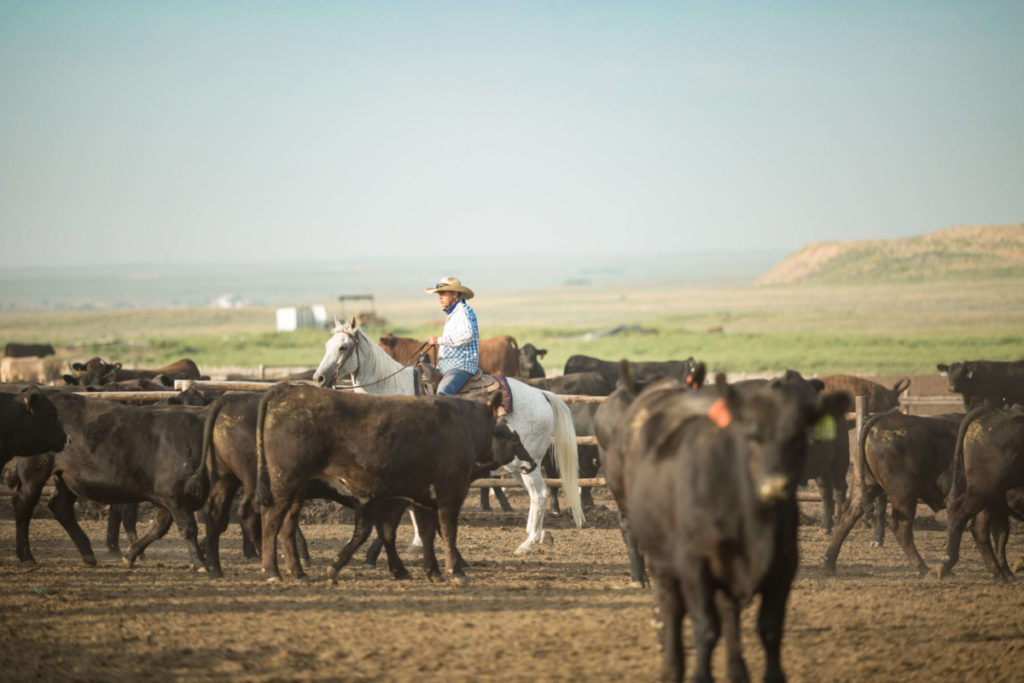Preguntas y respuestas Irsik y Doll Feedyard

marca sebranek
Lea sobre la importancia de un corral de engorde en el ciclo de vida de la carne.
WHAT’S A FEEDYARD (OR FEEDLOT)?
Un Feedyard es la tercera fase de la producción de carne de res, en esta etapa el animal tiene un cuerpo fuerte y está listo para aumentar de peso y agregar un poco de grasa, también conocido como marmoleo que hace que la carne de res sepa tan bien.
¿CÓMO SE RECIBEN GANADOS NUEVOS?
Las pequeñas cosas pueden hacer una gran diferencia. Primero, cuando llega el ganado, se tiene especial cuidado al descargarlo en el corral. (Los expertos universitarios nos ayudaron a diseñar un sistema de flujo fácil). Se les da comida, agua y se les permite aclimatarse. Al día siguiente, son llevados al Process Barn y se les administran las vacunas necesarias.
¿CÓMO MANTENER EL REGISTRO DE CADA ANIMAL INDIVIDUAL?
El ganado se identifica con etiquetas numeradas en las orejas, como un arete.
WHY ARE VACCINES IMPORTANT AND ISN’T IT HARD TO KEEP TRACK OF THE INFORMATION?
Un programa de inmunización previene enfermedades y mantiene la salud del rebaño. Los programas de vacunación resultan en menos animales enfermos, lo que requiere menos tratamiento y uso de antibióticos y menos estrés en los animales. Con la ayuda de la tecnología, los datos de los animales, como el peso, la condición y el historial de vacunación, se ingresan en el sistema informático y se pueden rastrear hasta el animal individual.
WHAT’S NEEDED TO MAINTAIN A HEALTHY HERD WHILE AT THE FEEDYARD?
El ganado necesita ejercicio adecuado, buena nutrición, agua limpia y espacio para acostarse. Se utilizan técnicas de manejo de bajo estrés en todo momento para prevenir enfermedades/lesiones.
¿QUÉ COME EL GANADO Y CON QUÉ FRECUENCIA SE ALIMENTA?
We feed our cattle three times a day, just like us – breakfast, lunch and dinner. They are fed at the same time everyday. We have consulting animal nutritionists that help us formulate balanced rations to ensure healthy weight gain for the cattle. Basically our rations consist of chopped alfalfa and flake corn, some protein pellets as well as micro ingredients (vitamins, minerals). We start with a higher ratio of chopped alfalfa and then slowly reduce the amount of hay and increase the corn. A high-energy diet helps marbling, improves the grade, helps the texture and ultimately provides a better eating experience. A good diet is important to animal health; we found that if cattle eat, drink and exercise – they’ll be healthy.
¿DÓNDE CONSIGUES TU ALIMENTACIÓN?
La mayoría de nuestro heno y maíz proviene de agricultores locales que se encuentran a unas pocas millas de nuestra operación.
¿SE TERMINA TODO EL GANADO AL MISMO TIEMPO?
Nuestra especialidad es el envío de ganado cuando está listo. Nuestro ganado es clasificado una cabeza a la vez fuera del corral por un vaquero. Estamos buscando ganado al que le vaya mejor en la planta empacadora. Nuestro objetivo es la mejor experiencia gastronómica para nuestros clientes.
¿CÓMO SABER CUANDO LOS ANIMALES ESTÁN ENFERMOS?
Pen Riders are “Caretakers” that are responsible for the health and well being of the cattle. They are specially trained to detect sickness. When an animal is sick, they are separated from the herd and moved to an Animal Care Facility. Here they are examined more closely and placed on a treatment program that can include special care and diet as well as medications if required to get well.
¿CÓMO SE UTILIZAN LOS ANTIBIÓTICOS?
Antibiotics are sometimes used to treat sick animals. Treating sick animals is expensive, so we focus on prevention and early detection of health challenges. We have better screening tools than in the past, and are better able to identify illnesses that need antibiotics and those that don’t. With the help of veterinarians, we are able to provide the right treatment for the right amount of time and get the animal home quicker. Preserving the effectiveness of antibiotics is a critical issue for both animal and human health. As pointed out by the American Association of Pediatrics (AAP), the overuse or misuse of antibiotics in both human and animal health could impact our ability to treat infectious diseases in both animals and humans. None of us want that to happen. We use the Beef Quality Assurance program and research to maintain high standards of animal care and health and to help us continuously improve how we use tools like antibiotics.
¿A DÓNDE VA TODO EL ESTIÉRCOL?
La sostenibilidad general es el objetivo de la agricultura. Al trabajar junto con los agricultores, el estiércol de los corrales de alimentación se utiliza como fertilizante y proporciona recursos en un ciclo equilibrado.
¿QUÉ TAN IMPORTANTES SON LAS ASOCIACIONES ENTRE GANADEROS, ALIMENTADORES Y PLANTAS DE EMPAQUE?
Everyone has the same goal – to provide the best beef eating experience. So the partnership between the segments is extremely important. The packing facility provides feedback on the cattle that can be relayed back to the rancher.
